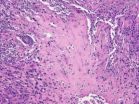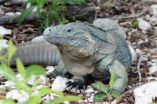(Press-News.org) Researchers at Mount Sinai School of Medicine have identified how a gene for a protein that can cause Type 2 diabetes, also possibly kills nerve cells in the brain, thereby contributing to Alzheimer's disease.
The gene, called SorCS1, controls the generation of amyloid-beta (Abeta) in the brain. Abeta plays a key role in the development of Alzheimer's disease. The researchers previously linked SorCS1 to Alzheimer's disease and identified where the molecules lived in the cell, but not how they control Abeta. The new data were presented today at the Alzheimer's Association's Annual International Conference in Paris.
Sam Gandy, MD, PhD, the Mount Sinai Professor in Alzheimer's Disease Research, Professor of Neurology and Psychiatry, and Associate Director of the Alzheimer's Disease Research Center at Mount Sinai School of Medicine, led the research team with Rachel Lane, PhD, a postdoctoral researcher in Dr. Gandy's lab.
The researchers determined various "traffic patterns" in the cell for the amyloid precursor protein (APP) that makes Abeta and uncovered how much APP is converted into the toxic, and ultimately nerve-killing, Abeta. In some experiments Drs. Lane and Gandy altered the dose of the diabetes gene, SorCS1, and evaluated how that changed the "traffic pattern" that APP used to move around the cell and generate Abeta. In other experiments, Dr. Lane made small changes in the SorCS1 gene's and again saw dramatic changes in the "traffic pattern" of APP around the cell.
These data suggest that SorCS1 controls the movement of APP within the cell between areas where Abeta is readily made to areas where Abeta is not so easily made. In turn, the "traffic pattern" of influences the amount of Abeta being made by cells. The implication is that people with deficiencies in SorCS1 are at higher risk of developing Alzheimer's disease because their APP spends too much time in the region of the cell where APP is broken down to make the toxic Abeta.
"The great thing about studying SorCS1," said Dr. Gandy, "is that we already have entirely new ideas about how to treat both Alzheimer's disease and type 2 diabetes. Our hunch is that SorCS1 also controls how the insulin receptor moves around the cell, but we have not yet proven that," he said. "With both diseases reaching epidemic proportions, this discovery is encouraging news that brings us one step closer to developing treatments."
###
This work was supported by the Cure Alzheimer's Fund.
Researchers identify how a gene linked to both Alzheimer's disease and type 2 diabetes works
2011-07-19
ELSE PRESS RELEASES FROM THIS DATE:
MIT: The tallest tree in the land
2011-07-19
CAMBRIDGE, Mass. -- The next time you're outdoors, see if you can spot the tallest tree. If you're in the desert Southwest, this may be an easy task — trees there are few and far between, and tend to hunch low to the ground to conserve resources. In the temperate Northeast, dense forests make the exercise a bit more difficult. And in the rainy Northwest, the towering stands of sequoias often reach higher than the eye can estimate.
Knowing how tall trees can grow in any given region can give ecologists a wealth of information, from the potential density of a forest and ...
Face value
2011-07-19
CAMBRIDGE, Mass. -- The looks of political candidates are a key factor influencing voters, a phenomenon identified by a number of scholars in recent years. Now, a new study by MIT political scientists adds to this body of research by detailing which types of citizens are most influenced by candidate appearances, and why: The tendency is most prevalent among low-information voters who watch a lot of television.
Using data from the 2006 U.S. Senate and governors' races, the study shows that for every 10-point increase in the advantage a candidate has when rated by voters ...
John Theurer Cancer Center researchers shared 14 leading edge studies at recent ASCO meeting
2011-07-19
HACKENSACK, N.J. (July 18, 2011) — Researchers from the John Theurer Cancer Center at Hackensack University Medical Center presented results from 14 cancer-related studies during the recently concluded American Society of Clinical Oncology (ASCO) Annual Meeting, which took place June 3 – 7, 2011 in Chicago. The studies examined new cancer treatments, ways to predict the best treatment outcomes, and patient quality of life issues.
"ASCO is a great venue for sharing best practices and learning about new treatment approaches – we are proud to help contribute by presenting ...
Click chemistry with copper -- a biocompatible version
2011-07-19
Biomolecular imaging can reveal a great deal of information about the inner workings of cells and one of the most attractive targets for imaging are glycans – sugars that are ubiquitous to living organisms and abundant on cell surfaces. Imaging a glycan requires that it be tagged or labeled. One of the best techniques for doing this is a technique called click chemistry. The original version of click chemistry could only be used on cells in vitro, not in living organisms, because the technique involved catalysis with copper, which is toxic at high micromolar concentrations. ...
Cancer stem cells recruit normal stem cells to fuel ovarian cancer, U-M study finds
2011-07-19
ANN ARBOR, Mich. — Researchers at the University of Michigan Comprehensive Cancer Center have found that a type of normal stem cell fuels ovarian cancer by encouraging cancer stem cells to grow.
Cancer stem cells are the small number of cells in a tumor that drive its growth and spread. Traditional cancer treatments do not kill these cells, which is why cancer treatments often fail.
In a study published online in the Journal of Clinical Investigation, researchers looked in ovarian tissue at the mesenchymal stem cells, which are normal cells found throughout the body. ...
New therapy provides hope for millions of people suffering from bowel incontinence
2011-07-19
CHICAGO- A new procedure is now available for the treatment of chronic bowel incontinence, a disorder impacting the lives of more than 18 million Americans. The treatment, called InterStim® Therapy is a minimally invasive procedure which uses electrical impulses to stimulate the sacral nerve and improve muscle function. It is one of the only effective long-term treatments for bowel incontinence available to patients and Northwestern Memorial Hospital is one of the first medical centers in the country to offer the procedure.
"Bowel control problems can have a significant, ...
Research identifies genes vital to preventing childhood leukemia
2011-07-19
Researchers at The University of Western Ontario have identified genes that may be important for preventing childhood leukemia. Acute lymphoblastic leukemia (ALL) is a cancer of the blood that occurs primarily in young children. It's frequently associated with mutations or chromosomal abnormalities that arise during embryonic or fetal development. Working with mice, researchers led by Rodney DeKoter identified two key genes that appear essential in the prevention of B cell ALL, the most common form of ALL in children. The study is published online in Blood, the Journal ...
Grand Cayman blue iguana: Back from the brink of extinction
2011-07-19
While thousands of species are threatened with extinction around the globe, efforts to save the Grand Cayman blue iguana represent a rarity in conservation: a chance for complete recovery, according to health experts from the Wildlife Conservation Society's Bronx Zoo and other members of the Blue Iguana Recovery Program.
Coordinated by the National Trust for the Cayman Islands, the Blue Iguana Recovery Program—a consortium of local and international partners—has successfully released more than 500 captive-bred reptiles since the initiative's inception in 2002, when the ...
Preschool-age kids in different countries improve academically using self-regulation game
2011-07-19
Children who regularly participated in a Simon Says-type game designed to improve self-regulation – called the Head-Toes-Knees-Shoulders task – may have better math and early literacy scores.
The study found that the higher academic outcomes associated with the game, which emphasizes careful listening and following instructions, does not just benefit students in the United States, but also benefits children tested in Taiwan, China and South Korea.
More than 800 preschool age children ages 3-6 years old in the four countries participated in the study, which was just ...
IADR/AADR publish study on use of Twitter for public health surveillance of dental pain
2011-07-19
Alexandria, VA, USA – The microblogging service Twitter is a new means for the public to communicate health concerns and could afford health care professionals new ways to communicate with patients. With the growing ubiquity of user-generated online content via social networking Web sites such as Twitter, it is clear we are experiencing a revolution in communication and information sharing. In a study titled "Public Health Surveillance of Dental Pain via Twitter," published in the Journal of Dental Research—the official publication of the International and American Associations ...



